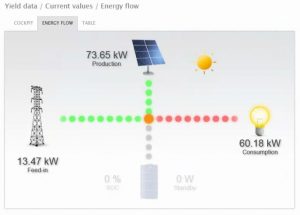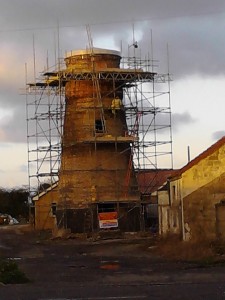Request a call back
Enter your details and we will call you back as soon as possible.
09:00 – 17:00 GMT (Monday–Friday).
By using this form you agree to us processing your personal data.
Being one of the largest producers of custom designed & built tanks in a variety of plastic & composite materials, Forbes have announced a further major investment in their tank production facilities to commence early in 2017.
Having made major investments over the past three years of over £1.5 million in the latest automated thermoplastic helix winding process, due to increased demand Forbes is extending the factory by 20% to enable an increased output. Tanks manufacture in this particular factory of Forbes, will range in diameters from 750mm up to 4000mm, and are manufactured in High Density Polyethylene (HDPE), highly chemical resistance grade PE-100.
With this latest investment, coupled with the state of the art automated equipment, high quality tanks at very competitive costs are achievable with capacities up to 100,000 litres designed to BS EN 12573. This expansion is at the company’s main manufacturing site is located in the Borders of Scotland at Kelso.
In 2013, Forbes brought a range of extra-large, helically wound tanks in polyethylene into production. Our investment in the helix winding process and, in particular, in our state of the art, automated equipment ensured that we could provide high capacity, high quality tanks at very competitive costs.
Fast forward three years, and we are pleased to announce that these ground-breaking thermoplastic tanks have gained approval to Regulation 31 of The Water Supply (Water Quality) Regulations 2016 (Statutory Instruments 2016 No 614) for use within the public water supply. Tanks under this approval are known as our ‘Jaguar Range’.
With capacities of over 100 cubic metres, diameters from 750mm to 4000mm and manufactured using the latest thermoplastic extrusion techniques, the ‘Jaguar Range’ is a welcome addition to the Forbes’ family.
And being free from welded seams and fabricated in corrosion-resistant, high density polyethylene PE 100 bimodal material, the ‘Jaguar Range’ is as strong and robust as its namesake.
The ‘Jaguar Range’ will compliment the already approved Forbes products; the ‘Cheetah Range’ – tanks in polypropylene material, ‘Lion Range’ – tanks in polypropylene reinforced with GRP with capacities up to 200 cubic metres and ‘Cheetah Tower Packings’ pall rings and AstraPAK in polypropylene.
Forbes is the largest custom built plastic tank manufacturer in the UK supplying all the major water utilities.
Our customers want to make tanker offloading of hazardous chemicals safer and more straightforward, and for many years Forbes had been commissioned to build bespoke filling point stations as part of turnkey installations.
The economical, new Forbes filling stations, ensure that a safe & secure point for the controlled delivery of hazardous chemicals is now available to even more customers.
Suitable for either pressurised or pumped tanker discharge, the offloading stations have been designed to maintain chemical containment when uncoupling the tanker hose. Drips and minor spillages are enclosed within the filling station.
A modular and compact design, either a single unit or multiple enclosures, the stations can be bolted together at one filling area as needed. The cabinet doors are fully lockable allowing the end user complete control over the tank filling process.
The labelling on each cabinet makes it clear which station feeds into which tank, as well as communicating its chemical contents.
Safe, secure and straight-forward. To find out more >>
The installation consists of 820 ground mounted solar panels generating energy used by Forbes and any over-production being fed back into the national grid.
Our goal was to supply up to 100% of the total on-site energy requirements, including seven injection moulding machines and air conditioning, and to significantly reduce our carbon footprint.
This target was exceeded in 2015 and despite the greyish skies of this year’s East Anglian summer, the yields for 2016 have averaged out to still be on target.
The energy produced by our solar panels means a reduction in the requirement for non-renewables, equivalent to:

In fact, the power generated is enough to meet the average energy requirements of 41 four-person households.
That’s enough energy for half of Crimplesham, the village that neighbours our Sales and Design Office!
Thanks to the installation the Forbes Group has been able to reduce its CO² emissions by over 258 tonnes a year – something that we’re all very proud of.
As Forbes continues to invest strongly in improved 3D design, both in terms of technology and staff expertise, it is timely to reflect on the advantages that this service offers over traditional 2D designs.
Storage tank and environmental technology fabrications are becoming increasingly complex. When fitting units into already complex sites, a combination of intricate pipework and space limitations can make for challenging conditions. This is where 3D planning comes into its own.
One of the key benefits of 3D design is clash detection. Being able to highlight potential clashes between objects and components while the unit is still ‘on the drawing board’ brings both time and cost benefits. Clash detection is particularly relevant in regard to complex pipework meaning issues can be identified well before fabrication or installation.
Finite element analysis is another important benefit. Our engineers are more easily able to apply any extremes of force, pressure and temperature to the model in order to visualise where the stresses and strains in each fabrication occur.
For more information on 3D design and turnkey installations please contact sales@forbesgroup.co.uk
Reflecting its on-going commitment to the development and training of its people, The Forbes Group is pleased to announce the recruitment of two new apprentice mechanical engineering designers in less than a year. This follows the success of a previous apprentice, whom after recently completing his apprenticeship is now working towards an HNC in Mechanical Engineering.
The Forbes apprenticeship scheme sees the trainees undertake a rigorous programme that includes on-the-job training in state-of-the-art, photo-realistic, 3D computer aided design (CAD) technology. The government recognised scheme also includes college day-release during which the apprentices can work towards a qualification in Mechanical Engineering.
Melvyn Jupp, Managing Director, said. “Investing in our apprentice designers, and increasing our in-house CAD capacity, will help ensure that The Forbes Group continues to remain at the cutting-edge of thermoplastic fabrication both now and in the future.”
In addition to the apprentices within the design office, Forbes also currently have a further 6 fabrication apprentices at their Kelso factories, in a training scheme being lead by EKGTA. The programme has been successfully run since 2006 at our Kelso works, with a possible further two apprentices to begin during the course of 2017.
Following our major investments over the past three years in the latest automated thermoplastic helix winding process, further diameters have now been added to the range. Initially offering diameters of 3000mm, 3500mm and 4000mm, we can now offer much smaller diameters also, with tank diameters now ranging from 750mm to 4000mm in High Density Polyethylene (HDPE) highly chemical resistance grade PE-100.
Managing Director, Melvyn Jupp, states “With some of the water utilities now specifying helically wound thermoplastic tanks, for even the smallest of tanks, we have fast tracked this further increase in capacity & diameter range. With this latest investment coupled with the state of the art automated equipment, high quality tanks at very competitive costs are achievable with capacities from 1,000 up to 100,000 litres.”
These thermoplastic tanks are designed to BS EN 12573.
For more information please contact us on +44 (0)1366 389600.
Further to Forbes £1.7 million investment in 2013 for the latest, state of the art machinery for producing helically wound tanks in HDPE PE-100, we are now expanding our production capacity & range of diameters, with the addition of a number of new mandrels.
This latest development will give us the capacity to produce thermoplastic helically wound tanks from 2 metres up to 4 metres diameter, allowing greater flexibility in meeting our customer’s needs.
These additions will enable us to utilise our highly efficient Krah production plant for a much increased range of these highly competitive thermoplastic tanks.
Along with our existing hoop wound GRP tanks, dual laminate thermoplastic/GRP tanks & our traditional thermoplastic fabricated tanks, we have full flexibility in offering the most suitable and cost effective materials for any application, up to capacities of 200’000 litres.
For over 150 years Simpsons Malt has been manufacturing specialist high quality malted barley. The company supplies to a large number of whisky distilleries throughout Scotland, as well as to the brewing and food industries at large.
The company’s largest site, Tweed Valley Maltings in Berwick on Tweed, produces an impressive 236,000 tonnes of malted barley annually.
THE PROBLEM
Chitted malt (barley) is transferred into giant stainless steel Germinating and Kilning Vessels (GKVs). Humidified air is passed through the bed of malting barley to create the perfect conditions for the barley to germinate.
After 4-6 days, the wet air is replaced with heated air. The malt is dried (White Malt) and cured to required specifications, both in terms of moisture levels and colour, where it is used to produce some of the finest single malt whisky in the world.
Some of the white malt receives a second treatment process; peat is burnt in large burners and the hot, peat-infused smoky air is drawn through the white malt to give it a distinctive peaty characteristic. This malt is then used in the production of those peat flavoured malts synonymous with the western isles of Scotland.
Previously the peaty / malty scented air, together with fine particulate, was vented straight to atmosphere. Needing to increase production Simpsons recognised their responsibility concerning discharges of odours and dust laden air generated from their process, and that cleaning before discharge to the environment was required before extra processing commenced.
THE SOLUTION
Forbes supplied a complete wet Venturi scrubber system. The scrubber fans now draw the heated air from the kiln, through the malting chamber and into the scrubber. Inside the scrubbing vessel, the scrubbing liquor and peaty gas stream are brought together in turbulent contact, within the venturi throat, where the odour-causing particulates are forced into the atomised liquor.
The result; no more unacceptable odours discharged from the GKV and a more pleasant environment for employees and neighbours alike.
THE SYSTEM
The scrubber vessel was manufactured in polypropylene and reinforced with GRP. With a throughput air flow rate of 23000 m3/h, the Simpsons Malt scrubber system’s duty is 97% particulate removal at 5 micron.
Along with the scrubber system itself, Forbes supplied all vents, ducting and fans, access ladders and handrails which were manufactured at our own Kelso steelworks.
The scrubber has delivered the specified duty and has permitted continuous production of peaty flavoured malt and allowed us to meet the increased demand for this specialist ingredient regardless of weather conditions.
KEY INFORMATION
 Forbes have recently completed a project a little out of the ordinary, in the form of a windmill roof. The unusual request came from a customer on the off chance Forbes would be able to assist with their expertise in GRP structures, albeit usually in the form of storage tanks and vessels.
Forbes have recently completed a project a little out of the ordinary, in the form of a windmill roof. The unusual request came from a customer on the off chance Forbes would be able to assist with their expertise in GRP structures, albeit usually in the form of storage tanks and vessels.
The conical roof was manufactured at 4111mm diameter, supplied in two parts for ease of transportation and assembled fully once on site. The roof was coloured to suit customer requirements, in order to replicate a traditional looking windmill roof and was supplied with a flanged lip to fix direct to the mills exposed brickwork.
Enter your details and we will call you back as soon as possible.
09:00 – 17:00 GMT (Monday–Friday).
By using this form you agree to us processing your personal data.